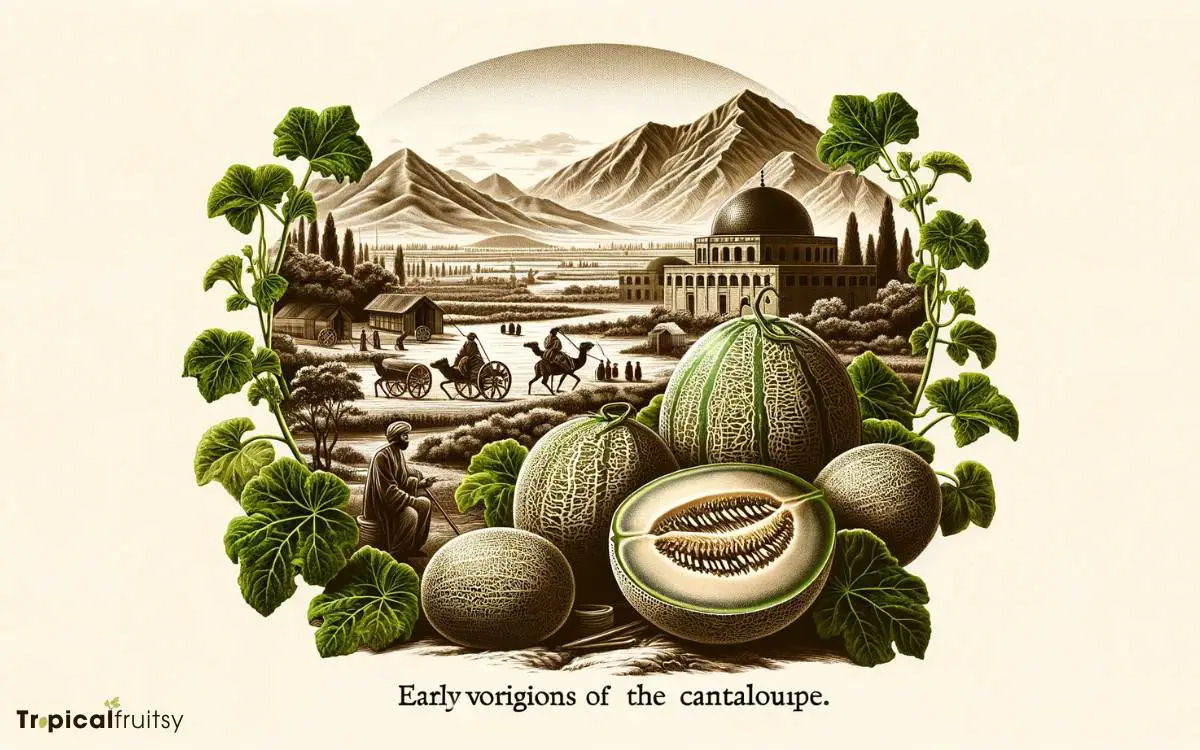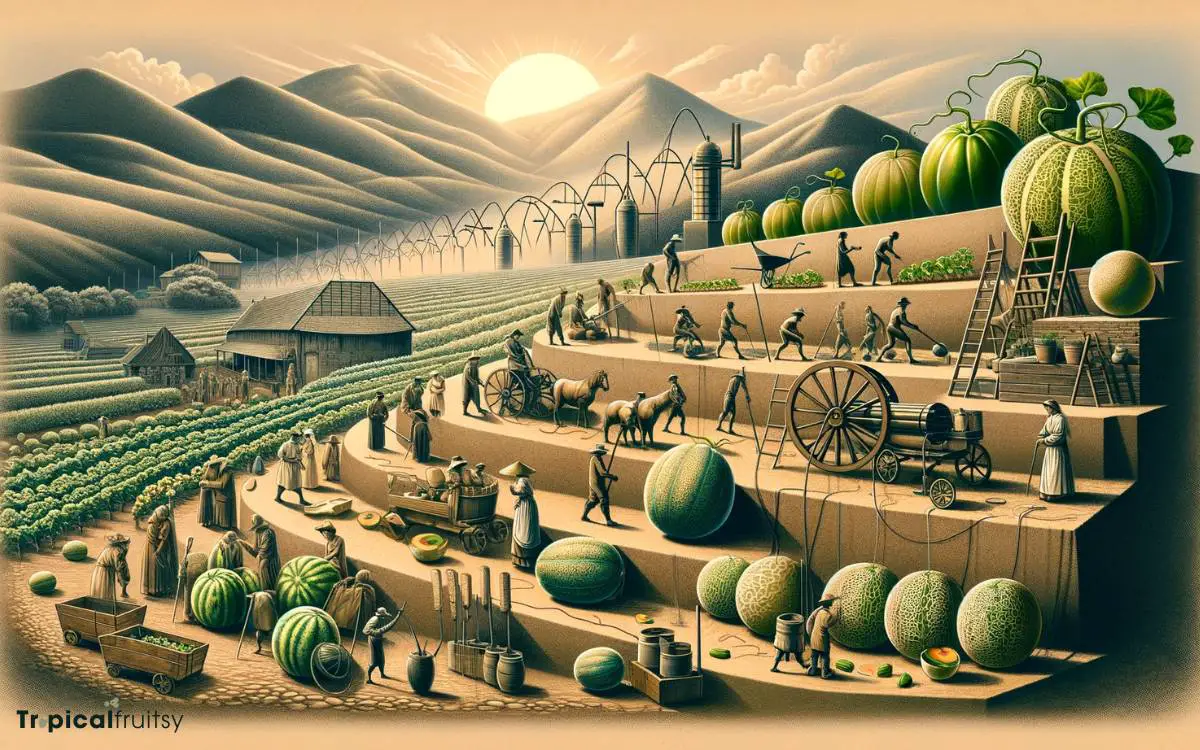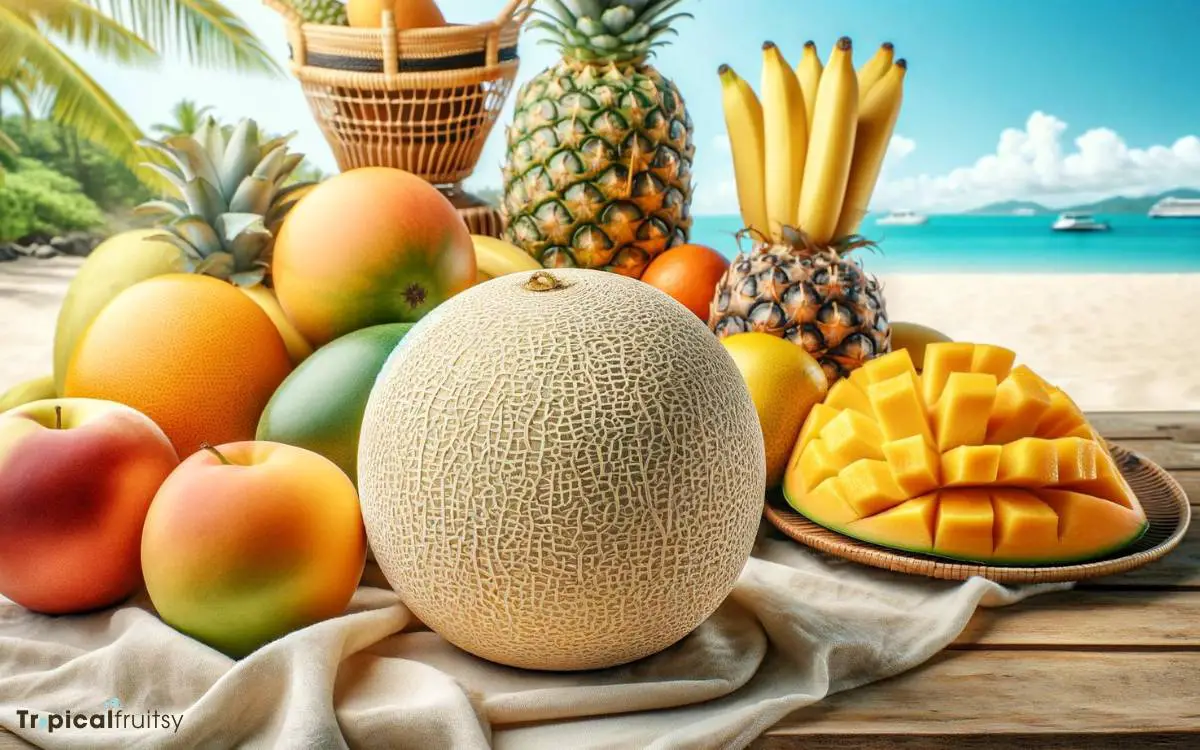Is Cantaloupe a Tropical Fruit? No!
Cantaloupe is not typically classified as a tropical fruit. It is best described as a type of melon that prefers warm, temperate climates rather than the equatorial regions commonly associated with tropical fruits.
Understanding the classification of cantaloupe involves looking at its preferred growing conditions.
Unlike tropical fruits that require a consistently hot climate:
Cantaloupe cultivation history and its nutritional profile also play roles in its classification but do not categorically place it with tropical fruits.
Cantaloupe’s versatility in growing beyond equatorial climates suggests it’s not a true tropical fruit.

Key Takeaway
4 Criteria: Is Cantaloupe a Tropical Fruit
| Criteria | Tropical Fruits | Cantaloupe |
|---|---|---|
| Growth Climate | Equatorial, consistently warm | Temperate and adaptable to some warm regions |
| Location | Near the equator | Grown in temperate zones worldwide |
| Temperature Range | Usually above 20°C (68°F) year-round | Prefers 65-75°F (18-24°C), can tolerate higher temperatures |
| Sunlight Exposure | High, consistent | High but tolerant to varying conditions |
Understanding Cantaloupe Origins

We must trace the cantaloupe’s origins back to Africa and Persia to determine if it classifies as a tropical fruit.
The genesis of the Cantaloupe, Cucumis melo, lies within the Cucurbitaceae family, which shows a broad adaptability to various climatic regions.
Genomic analysis and historical agricultural texts suggest that the cantaloupe diverged from its wild ancestors and underwent domestication in these regions, where arid conditions prevail rather than the humid, equatorial climate typical of tropical zones.
The term ‘tropical’ is often applied to fruits indigenous to regions within the Tropics of Cancer and Capricorn; however, cantaloupes thrive in temperate zones as well.
This suggests that while cantaloupes can grow in tropical climates, their adaptability does not strictly confine them to this category.
Defining Tropical Fruits

Tropical fruits are typically grown in the tropics, the region of the Earth surrounding the Equator, known for its warm and humid climate.
These fruits are characterized by their ability to thrive in these conditions, where temperature fluctuations are minimal and frost is virtually absent.
Climatic Requirements:
- Constant warmth
- High humidity
Growth Adaptations:
- Thick skins to prevent moisture loss
- Vivid colors to attract pollinators in dense foliage
Harvesting and Post-Harvest:
- Often handpicked to maintain integrity
- Rapid perishability necessitates swift transport
Understanding the precise botanical criteria and environmental necessities provides a foundation for classifying fruits like cantaloupe within or outside the tropical category.
Cantaloupe Growth and Climate

The cultivation of cantaloupe, Cucumis melo, necessitates a careful consideration of climatic factors to ensure optimal growth and fruit production.
Cantaloupes require a temperature range between 65°F and 95°F, with soil temperatures ideally above 70°F for germination, highlighting the plant’s thermophilic nature.
Proper irrigation is critical, as cantaloupes demand consistent moisture levels, particularly during fruit set and expansion.
Cantaloupes also necessitate high sunlight exposure to maximize photosynthetic activity and sugar accumulation within the fruits.
Optimal Temperature Range
Optimal cantaloupe cultivation requires a consistent temperature range between 65°F and 95°F (18°C and 35°C).
Within this thermal spectrum, the melon’s biological processes are optimized, ensuring:
Germination and Seedling Growth:
- Temperature Sensitivity: Seed germination is maximized around 90°F (32°C).
- Thermophilic Response: Young plants exhibit robust growth in warmer conditions.
Fruit Development:
- Photosynthetic Efficiency: Elevated temperatures enhance sugar accumulation.
- Ripening Acceleration: Warmth promotes enzymatic activities that mature the fruit.
Pest and Disease Management:
- Pathogenic Suppression: Consistent warmth helps suppress certain fungi and bacteria.
- Pest Life Cycle Disruption: Higher temperatures can disrupt the life cycle of harmful insects.
An analytical review of temperature effects reveals the interplay between heat and melon productivity.
With temperature being a pivotal factor, it naturally segues into the importance of irrigation practices, as water availability becomes crucial in modulating the cantaloupe’s microclimate.
Watering Needs
Cantaloupe cultivation demands regular and abundant irrigation, particularly in arid climates, to maintain soil moisture conducive to fruit development and overall plant health.
Precision in watering is critical; overwatering can lead to root rot, while under-watering can stress the plant, affecting yield and sweetness of the fruits.
An analytical approach to irrigation considers factors such as soil type, weather patterns, and plant growth stage.
To elucidate, the table below presents key watering considerations:
| Growth Stage | Watering Strategy |
|---|---|
| Seedling | Consistent moisture to establish roots |
| Flowering & Fruiting | Increased water for fruit set and development |
| Pre-Harvest | Reduced watering to concentrate sugars in fruit |
Adhering to these guidelines supports optimal cantaloupe growth, balancing the need for sufficient water with the risk of over-saturation.
Sunlight Exposure Requirements
Adequate sunlight exposure, typically between 8 to 10 hours daily, is essential for the healthy growth and fruit production of cantaloupe plants.
The intensity and duration of sunlight directly influence photosynthetic activity, which is critical for the synthesis of sugars within the fruit, impacting both yield and sweetness.
Cantaloupes thrive in warm, temperate to subtropical climates where long, sunny days are the norm during the growing season.
Sunlight and Cantaloupe Development:
- Photosynthesis Maximization: Optimal sunlight exposure enhances chlorophyll function, driving energy conversion.
- Fruit Quality: Adequate sun exposure ensures high sugar content and desirable texture.
- Yield Enhancement: Sufficient sunlight correlates with increased flower and fruit set, boosting overall productivity.
Comparing Cantaloupe to Tropical Counterparts

When juxtaposed with tropical fruits, cantaloupe exhibits distinct climatic growth requirements, necessitating a comparative analysis of their respective cultivation conditions.
The variance in flavor profiles between cantaloupe and tropical fruits underscores the importance of understanding the biochemical processes that contribute to their unique tastes.
Furthermore, a technical comparison of their nutritional content can illuminate potential benefits and shortcomings relative to a diet rich in tropical fruit varieties.
Climate Growth Differences
Examining the climatic requirements of cantaloupe reveals distinct differences from those of its tropical counterparts, particularly in terms of temperature and humidity preferences.
Cantaloupes require a temperate climate with warm, dry days and cool nights, which is essential for the development of their sweet flavor.
In contrast, tropical fruits typically flourish in conditions with higher average temperatures that are conducive to rapid growth and maturation. These conditions often lead to a year-round growing season.
Tropical fruits also thrive in elevated humidity levels, which provide the moisture necessary for these fruits to thrive and can protect them from the stress of excessive transpiration.
Consistent rainfall or access to irrigation is another requirement for tropical fruits. This ensures a continuous supply of water and prevents the stress conditions that can adversely affect fruit quality.
These distinctions underscore the incompatibility of cantaloupe with truly tropical environments.
Flavor Profile Variance
Most cantaloupes exhibit a distinctly milder sweetness and less acidic profile compared to many tropical fruits, which often boast intense flavors and higher sugar concentrations.
This variance can be attributed to the differing levels of inherent sugars, primarily fructose, and organic acids present within the fruits’ cellular structures.
Cantaloupes generally have a balanced ratio of fructose to glucose, which accounts for their subtler sweetness. Conversely, many tropical fruits contain higher fructose ratios, enhancing their sweet perception.
Additionally, the enzymatic activity in cantaloupes tends to result in a less pronounced acidity, unlike tropical fruits that often contain higher levels of citric and malic acids, contributing to a sharper taste profile.
This contrast is paramount when considering the sensory experience and culinary applications of these fruits.
Nutritional Content Comparison
Cantaloupe’s nutritional profile offers a distinct contrast to its tropical counterparts, with a notable emphasis on vitamin A and C content. Its rich composition provides essential micronutrients that are pivotal for maintaining robust health.
Vitamin A:
- Cantaloupe: High in beta-carotene, which converts to vitamin A; crucial for vision and immune function.
- Mango: Contains vitamin A, but less per serving.
- Papaya: Comparable levels, promoting skin health and vision.
Vitamin C:
- Cantaloupe: Abundant; supports immune defense and collagen synthesis.
- Pineapple: Also rich; contains bromelain, aiding digestion.
- Kiwi: Higher per serving; supports heart health, skin quality.
Fiber:
- Cantaloupe: Moderate; enhances satiety and digestive health.
- Banana: Similar amounts; supports bowel regularity.
- Guava: Higher; aids in cholesterol management, glucose regulation.
In the context of micronutrients, cantaloupe’s profile is particularly compelling for those focused on ocular and immunological health benefits.
Historical Cultivation of Cantaloupe

Delving into the historical cultivation of cantaloupe, it is evident that this fruit has its origins in regions of Africa and Iran, from where it spread to Europe and subsequently to other parts of the world.
The dissemination of cantaloupe can be studied through various historical texts and agricultural records, indicating a trajectory of cultivation practices adapted to different climates and soils.
Its adaptability to temperate climates contributed to its proliferation across the European continent.
| Region | Significance in Cantaloupe History |
|---|---|
| Africa | Origin and early cultivation |
| Iran | Secondary center of diversity |
| Europe | Adaptation and spread |
| New World | Expansion of cultivation |
This analysis underscores the evolutionary agronomy of cantaloupe, highlighting its journey from wild varieties to the selectively bred cultivars we recognize today.
Moving forward, the nutritional profile of cantaloupe will be examined to shed light on the health benefits that may have contributed to its historical popularity.
Nutritional Profile of Cantaloupe

A single cup of cantaloupe provides approximately 60 calories, along with a rich supply of vitamins A and C, potassium, and a host of other nutrients.
The fruit’s nutritional profile is noteworthy:
Vitamins:
- Vitamin A: Essential for eye health, with a single serving delivering over 100% of the daily recommended intake.
- Vitamin C: Supports immune function and skin health, contributing to nearly 100% of the daily requirement.
Minerals:
- Potassium: Vital for muscle function and heart health.
Hydration and Dietary Fiber:
- Water Content: High water content aids in hydration.
- Fiber: Promotes digestive health and can help in weight management.
This detailed examination underscores the fruit’s nutritional significance.
Now, let’s turn our attention to how cantaloupe integrates into global cuisines.
Cantaloupe in Global Cuisines

In culinary traditions worldwide, cantaloupe is incorporated into a variety of dishes, reflecting its versatility and widespread popularity.
Its sweet, musky flesh is not only consumed fresh but also is utilized in both savory and sweet culinary applications.
In the Americas, cantaloupe is often found in fruit salads or served with a splash of lime to enhance its natural sweetness.
European cuisine might pair it with cured meats such as prosciutto, creating a balance of sweet and savory notes.
In Asian dishes, cantaloupe is frequently blended into smoothies or served as a refreshing dessert, sometimes accompanied by sago pearls and coconut milk.
The culinary integration of cantaloupe is methodical, with chefs capitalizing on its texture and flavor to complement and contrast other elements within a dish.
Can Cantaloupe be Considered as a Tropical Fruit?
The debate over whether cantaloupe can be considered as a tropical fruit continues. While it’s not native to tropical regions, its sweet, juicy flesh and refreshing taste have earned it a place among exotic tropical fruit delights. Its vibrant color, unique flavor, and juicy texture make it a favorite among fruit lovers.
The Verdict: Tropical or Not?

Considering its global culinary integration, the classification of cantaloupe as a tropical fruit requires examination of its botanical origins and preferred growing conditions.
Scientifically known as Cucumis melo, cantaloupe thrives in warm, temperate climates rather than the humid, consistently hot environments typical of the tropics.
Botanical Classification:
- Family: Cucurbitaceae
- Genus: Cucumis
- Species: melo
Growth Preferences:
- Climate: Warm, temperate regions
- Temperature: Optimal between 65°F and 95°F (18°C – 35°C)
- Soil: Well-drained, nutrient-rich
Geographical Origins:
- Historical: Likely originated in Africa or South Asia
- Cultivation: Extends beyond typical tropical zones
Given these factors, cantaloupe is more accurately described as a non-tropical melon. Its adaptability to temperate locales defies the tropical fruit nomenclature, appealing to a global palate but rooted in a specific horticultural identity.
Conclusion
Cantaloupe, while thriving in warm conditions reminiscent of a sun-kissed climate, does not fit the stringent criteria defining tropical fruits.
Its origins and cultivation history place it outside the equatorial embrace where true tropical fruits flourish.
Cantaloupe’s nutritional bounty is a testament to its widespread adaptability rather than a hallmark of tropical lineage.
Thus, it remains a refreshing enigma, akin to an oasis in the desert, offering succulence without claiming tropical heritage.






